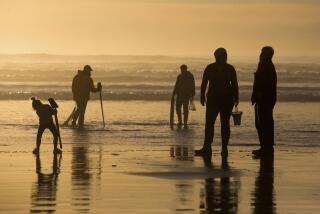Maine Hopes Experiment With Mollusk Shuckings Will Save State a Few Clamshells
- Share via
PORTLAND, Me. — When the snow melts this spring, state officials will anxiously gather along a section of Interstate 295 to see if a pile of crushed clamshells did anything to damage the soil on the highway’s median strip.
If the soil is unharmed, Maine officials may have finally figured out what to do with an ever-growing pile of surf clamshells behind Bailey’s Seafood in the Pine Point section of Scarborough.
The shells, a headache for clammers and state environmental officials, could end up as decorative landscaping material. If the shells do not disturb the soil quality, a growing environmental headache may be cured while clammers reap some extra income.
The growing pile of clamshells at Pine Point stems from a loophole in the law governing how shellfish may be handled. The problem began when waters in the Pine Point area became clean enough for clammers to begin harvesting surf clams for the first time in many years.
Standards for Shellfish
The law, the National Shellfish Sanitation Program, is a federal statute that establishes standards for the handling and transportation of shellfish. Maine participates in the federal law, but surf clams were not included in the legislation at first because Maine’s only surf clam beds had been polluted and unused for many years.
Since surf clams were not included in the law, fishermen simply pulled the clams on board their boats, shucked them, threw the shells overboard and landed only the clam meat. Later, however, the law was updated to included the surf clams. And that is when the pile of shells began to grow behind Bailey’s Seafood.
“The law required that the shucking had to be done in a certified shucking house,” said Peter Beves, head of the state Department of Marine Resources’ fisheries technology service.
Disposal Problem
That meant no more on-board shucking, and no more tossing shells overboard. Fishermen began landing the clams, shell and all, and that meant the clamshell had to be disposed of somewhere on land.
“When they had to land the whole clam, that made it a land-based disposal problem,” Beves said. “And the landfills wouldn’t take the shells because they were too bulky and they didn’t crush down too well.”
The growing pile of white clamshells got Beves to thinking about finding a way to use the shells, rather than simply finding a place to throw them away. The color of the shells reminded him544171552landscaping, and he began to look into the possibility of developing the shells as landscaping material.
Beves got the state Department of Transportation interested in his idea, and they have been helping to experiment with the shells.
Border for Junipers
“The Department of Transportation got interested enough to try a test plot on the median strip of Route 295 in Portland, near the Forest Avenue exit,” Beves said. “They are using the crushed shells as a border around some juniper beds.”
“The question is whether the shells have any impact on the soil,” Beves said. He said they are mostly calcium with a little phosphorous.
“If it works out, the clamshells could make a pretty good substitute for crushed white marble, which has gotten pretty expensive,” Beves said. “It might also be used as a substitute for wood chip mulch, which is getting very high.”
More to Read
Sign up for Essential California
The most important California stories and recommendations in your inbox every morning.
You may occasionally receive promotional content from the Los Angeles Times.













